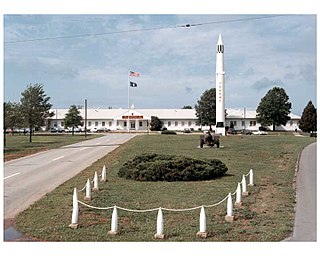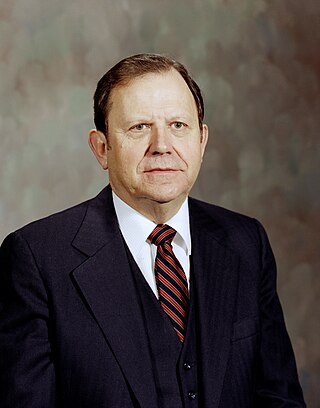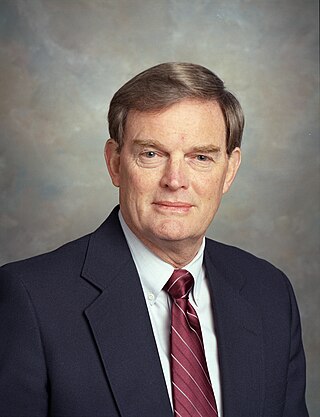
Huntsville is a city in Madison County and Limestone County, Alabama, United States, with a small portion extending into Morgan County. It is the county seat of Madison County. Located in the Appalachian region of northern Alabama, Huntsville is the most populous city in the state.

Redstone Arsenal (RSA) is a United States Army post and a census-designated place (CDP) adjacent to Huntsville in Madison County, Alabama, United States and is part of the Huntsville-Decatur Combined Statistical Area. The Arsenal is a garrison for various tenants across the Department of Defense, Department of Justice, and NASA. RSA has benefited from decisions by the Defense Base Realignment and Closure Commission. The Redstone Arsenal CDP had a residential population of 837 as of the 2020 census. The base contains a government and contractor workforce that averages 36,000 to 40,000 personnel daily.

The PGM-11 Redstone was the first large American ballistic missile. A short-range ballistic missile (SRBM), it was in active service with the United States Army in West Germany from June 1958 to June 1964 as part of NATO's Cold War defense of Western Europe. It was the first US missile to carry a live nuclear warhead, in the 1958 Pacific Ocean weapons test, Hardtack Teak.

The University of Alabama in Huntsville (UAH) is a public research university in Huntsville, Alabama. The university is accredited by the Southern Association of Colleges and Schools and comprises nine colleges: arts, humanities & social sciences; business; education; engineering; honors; nursing; professional & continuing studies; science; and graduate. The university's enrollment is approximately 10,000. It is part of the University of Alabama System and is classified among "R1: Doctoral Universities: Very High Research Activity".

Ernst Stuhlinger was a German-American atomic, electrical, and rocket scientist. After being brought to the United States as part of Operation Paperclip, he developed guidance systems with Wernher von Braun's team for the US Army, and later was a scientist with NASA. He was also instrumental in the development of the ion engine for long-endurance space flight, and a wide variety of scientific experiments.

Eberhard Friedrich Michael Rees was a German-American rocketry pioneer and the second director of NASA's Marshall Space Flight Center.

William R. Lucas was the fourth Director of the NASA Marshall Space Flight Center. He served as director from June 15, 1974, to July 3, 1986.

Thomas Jack Lee was the sixth Director of the NASA Marshall Space Flight Center in Huntsville, Alabama, from July 6, 1989 to January 6, 1994.

Konrad Dannenberg was a German-American rocket pioneer and member of the German rocket team brought to the United States after World War II.

The Redstone Test Stand or Interim Test Stand was used to develop and test fire the Redstone missile, Jupiter-C sounding rocket, Juno I launch vehicle and Mercury-Redstone launch vehicle. It was declared an Alabama Historic Civil Engineering Landmark in 1979 and a National Historic Landmark in 1985. It is located at NASA's George C. Marshall Space Flight Center (MSFC) in Huntsville, Alabama on the Redstone Arsenal, designated Building 4665. The Redstone missile was the first missile to detonate a nuclear weapon. Jupiter-C launched to test components for the Jupiter missile. Juno I put the first American satellite Explorer 1 into orbit. Mercury Redstone carried the first American astronaut Alan Shepard into space. The Redstone earned the name "Old Reliable" because of this facility and the improvements it made possible.
Georg Heinrich Patrick Baron von Tiesenhausen was a Baltic-German-born American rocket scientist.
Heinz-Hermann Koelle was a German aeronautical engineer who made the preliminary designs on the rocket that would emerge as the Saturn I. Closely associated with Wernher von Braun's team at the Army Ballistic Missile Agency (ABMA), he was a member of the launch crew on Explorer 1 and later directed the Marshall Space Flight Center's involvement in Project Apollo. In 1965, he accepted the Chair of Space Technology at the Technical University of Berlin.
Milton Kyser Cummings had a noteworthy career in two highly diverse fields: cotton broker and space-defense industry executive. Sometimes called the "Number One Citizen of Huntsville" and a "Symbol of the New South," he was recognized as a humanitarian, leader in opportunities for minorities and the handicapped, and advisor to government officials and congressmen. The Cummings Research Park, the second largest park of this type in America, was named to honor him.
Heinz Hilten was a German-American architect and member of the "von Braun rocket team." He was a later Operation Paperclip hire and was involved in the design of numerous buildings in Space Age-era Huntsville, Alabama, both for NASA and for general use.
Gerhard Herbert Richard Reisig was a German-American engineer and rocket scientist. He worked at the Peenemünde Army Research Center during World War II and later, through Operation Paperclip, at the Marshall Space Flight Center.
Helmut Justus Karl Horn was a German-American engineer and applied physicist who was employed at the early Marshall Space Flight Center. Horn worked first at the Peenemünde Army Research Center and later, after the end of World War II, was hired by the U.S. through Operation Paperclip.
Gerhard B. Heller was a German-American rocket scientist and member of the "von Braun rocket team." He worked at Peenemünde Army Research Center during World War II and later, through Operation Paperclip, moved to develop rockets for the U.S., eventually becoming employed at the Marshall Space Flight Center.

Heinrich Georg "Heinz" Struck was a German-American rocket scientist and member of the "von Braun rocket team." Struck worked in aerodynamics in both the private and federal sectors, particularly NASA, where he was recognized for his contributions to the Space Shuttle program.
George Landwehr von Pragenau was an Austrian-American engineer and rocket scientist. Brought to the U.S. by the Army for his work with transistors, he was heavily involved with the testing of the Saturn I and Saturn V rockets and the Space Shuttle. In 1985 he received NASA's Inventor of the Year Award for his work in stabilizing the Shuttle's fuel pumps.












